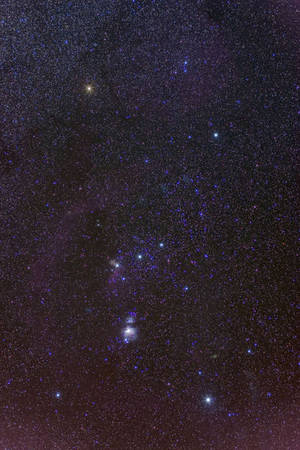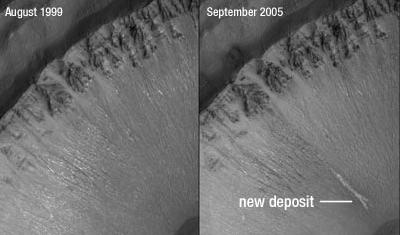Skygazing
Interview with
Dave - Now it's time to hear from Rick Fienberg of Sky and Telescope Magazine. Rick spoke to Meera earlier this week about the latest developments this week in space. First up, GLOBEatnight: a project to bring together both professional and amateur astronomers with the public and get them all skygazing.
 Rick - One of the newest things that's happened already is a worldwide effort on the part of professional astronomers and amateur astronomers and even among ordinary citizens to measure the darkness or brightness of the night sky to try to figure out what the impact of light pollution is. When astronomers talk about light pollution we're talking about artificial lighting which is wastefully being shot up into the sky, causing faint stars to disappear. Most people live in cities now and they rarely get to see the night sky in all its glory.
Rick - One of the newest things that's happened already is a worldwide effort on the part of professional astronomers and amateur astronomers and even among ordinary citizens to measure the darkness or brightness of the night sky to try to figure out what the impact of light pollution is. When astronomers talk about light pollution we're talking about artificial lighting which is wastefully being shot up into the sky, causing faint stars to disappear. Most people live in cities now and they rarely get to see the night sky in all its glory.
Meera - What's the project actually getting people to do?
Rick - The GLOBE project is very simple, they ask people to go out at night in late February and early March and look at the constellation Orion which is very familiar to most stargazers and visible to most points of the Earth at this time of year. They count how many stars they can see in the constellation and they compare their view of the constellation with the templates that are on the GLOBEatnight website and determine whether they're seeing stars that are at a third magnitude or a fainter fourth magnitude or even fainter fifth magnitude. That's how astronomers measure star brightness. That enables the GLOBEatnight project to do a worldwide map of sky brightness.
Meera - Has anything been revealed so far?
Rick - Well, this is the third year. In 2006, 2007 they had something like 10-20,000 participants doing measurements and they've been able to determine that measurements done from the ground by people track very consistently with measurements done by satellites in orbit which is useful. If the information didn't match up we might begin to suspect that your satellites weren't operating properly. As you might expect, most of the light pollution is located in populous cities. One of the interesting things is that it's possible, if you have a large number of people doing measurements, in any particular city to find little enclaves where the night sky is a bit darker than surrounding areas. These are places where amateur astronomers are going to want to sit their telescopes because they'll be able to see more.
Meera - That would be quite useful for people just to know their local best spot.
Rick - Right and the GLOBEatnight project is planning to be much larger in 2009 because next year is the International Year of Astronomy that celebrates 400 years of telescope. Galileo first used the telescope to look at the stars in 1609. The plan is to have a lot more people than have been participating in the GLOBEatnight so far rejoin so that awareness of light pollution will be raised around the world.
Meera - Well, hopefully all will go well with the project and the number of astronomers out there will increase. Moving from the stars to the planets it turns out that the liquid water that was thought to have existed on Mars wasn't there at all.
 Rick - NASA's plan for studying Mars is to follow the water. That's how they put it. If you follow the water, you follow lines of evidence that might ultimately point toward life on other worlds. Astronomers have seen lots of evidence that liquid water flowed on Mars in the distant past. We have huge canyons on Mars, we have things that look exactly like river deltas so there's very little argument over the probability that liquid water flowed on the planet many, many years ago: we're talking millions or even billions of years ago. The question is, is there liquid water on Mars today? In late 2006, using images from the Mars Global Surveyor, several planetary scientists saw evidence that liquid water can actually flow on Mars even now. What they saw was a couple of gullies that were cut into the sides of craters. These gullies had suddenly fresh, light-coloured deposits in them. The thought was that between the time when the images were taken there were no deposits and then there were deposits liquid water had somehow erupted out of the gullies, probably from underground and slowed down and dropped some rocks into these gullies, causing them to look different than they had a few years earlier.
Rick - NASA's plan for studying Mars is to follow the water. That's how they put it. If you follow the water, you follow lines of evidence that might ultimately point toward life on other worlds. Astronomers have seen lots of evidence that liquid water flowed on Mars in the distant past. We have huge canyons on Mars, we have things that look exactly like river deltas so there's very little argument over the probability that liquid water flowed on the planet many, many years ago: we're talking millions or even billions of years ago. The question is, is there liquid water on Mars today? In late 2006, using images from the Mars Global Surveyor, several planetary scientists saw evidence that liquid water can actually flow on Mars even now. What they saw was a couple of gullies that were cut into the sides of craters. These gullies had suddenly fresh, light-coloured deposits in them. The thought was that between the time when the images were taken there were no deposits and then there were deposits liquid water had somehow erupted out of the gullies, probably from underground and slowed down and dropped some rocks into these gullies, causing them to look different than they had a few years earlier.
Meera - What's happened to make them not think this any more?
Rick - Now there's a much higher resolution camera in orbit on Mars (the Mars Reconnaissance Orbiter) and those craters that had the gullies in them were retargeted. Much higher resolution images enabled planetary scientists to build a computer model that tries to explain how these gulley deposits were laid down. What they did was they now had really good three-dimensional maps of the gullies. They simulated the creation of these light, streaky deposits through liquid flow, through a mud flow or a lava flow or through something more like a landslide: as if a hill had collapsed and all kinds of particles and rocks and dust had flown down. What they found was that they could reproduce the appearance of these deposits in the gullies much more precisely using a dry flow, something like a landslide than they could using a wet flow as if there had been a flash-flood in these gullies. Suddenly, the compelling evidence that liquid water had flowed on Mars as recently as the last few years was cast into doubt.
- Previous The Ig Nobel Prizes
- Next The Science of the Voice









Comments
Add a comment